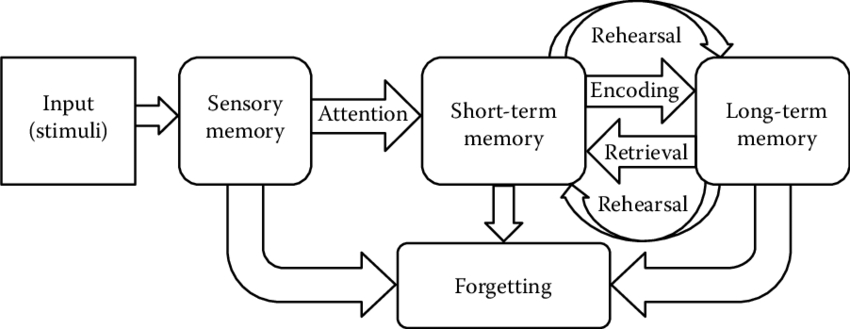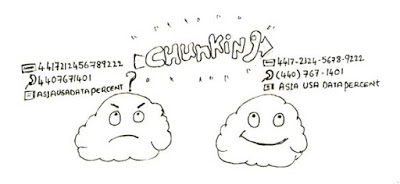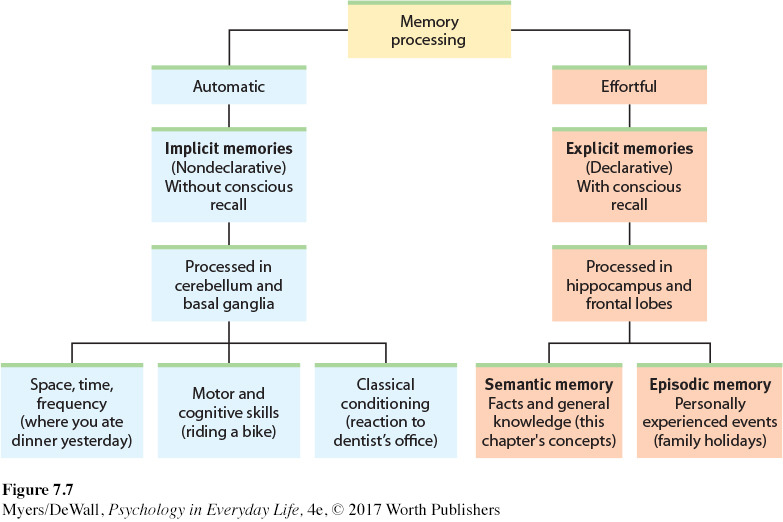Dalia Savy
Sadiyya Holsey
AP Psychology 🧠
334 resourcesSee Units
Storage is the process of maintaining or keeping information readily available. The three types of storage are short term memory, long term memory, and sensory memory.
Three-Stage Model
The Atkinson-Shiffrin three-stage model is a model that shows information going from shallow to deep memory with the three processes (encoding, storage, and retrieval). Here it is:

Image Courtesy of Research Gate.
Even though we went over these terms a bit, let's review them once more and connect them to this model.
Sensory Memory
Events come from the environment into your sensory memory. They stay here long enough so that they could move into your short-term memory. For example when you walk past someone on the street, you see what they wear, but you don't really pay attention. However, when you notice that they are wearing the shirt with your favorite band on it, it crosses into your short-term memory from your sensory memory. If you pay less attention to a task when visually noticing it, you'll quickly forget it.
Iconic Memory
A short sensory memory of visual stimuli 👀 This lasts less than a second!
Echoic Memory
A short sensory memory of auditory stimuli👂 An echoic memory lasts about 3-4 seconds, just long enough for us to hear a sentence without forgetting the beginning of it.
💡Tip—The best way to remember the difference is to look at "icon" and "echo." Icon refers to something you see, whereas echo refers to something you hear.
Short-Term Memory (STM)
Our short-term memory holds a few pieces of information briefly. It disappears really quickly and is either stored farther into the memory system or forgotten completely. This all depends on how much attention you pay to the information and how much you rehearse the information.
If you were asked to remember a chain of numbers, such as 3 6 2 8 1 8 4 7 9 4, and given only 1 second to do so, you'd probably only remember the first 7. The magic number is really 7, but the range is 7 +/- 2.
Chunking
Chunking is the process of grouping information to be stored or processed as single concepts. The most common form of chunking occurs with cell phone numbers📱📞 For example, a phone number with the sequence 3-6-2-8-1-8-4-7-9-4 can be chunked as 362-818-4794.

Image Courtesy of UXness.
Another way to store something in the short term memory is mnemonic devices. This is also an example of chunking. "My Very Educated Mother Just Served Us Noodles" is a good example of a mnemonic device that helps you memorize the planets with the first letters of the names. Lastly, another way to retain short-term memory is to rehearse it. If you're trying to memorize a phone number, repeating it to yourself can help you chunk it into your memory.
Chunking increases how much we can store in our short-term memory. If you chunk information, it is much easier to remember it. Didn't chunking this sequence make it so much easier to remember it?
Long-Term Memory (LTM)
Permanent memories! Our long-term memory is completely limitless ♾️; we can store as much information here as possible and it can easily be recalled. This includes facts, skills, and things like flashbulb memories.
Long-term memory can be broken up into several categories, the first being explicit memory and implicit memory.
Explicit Memory (Declarative Memory)
Explicit memory is the stored memory of facts. For example, explicit memory is knowing how many continents there are 🌎 You can split this up into further categories:
- Semantic—the memory of facts, ideas, and concepts.
- Episodic—memories of personal experiences. An example would be telling a friend about the first time you learned how to knit 🧶
Implicit Memory (Non-Declarative Memory)
Implicit memory is memory that is remembered unconsciously.
One of the most common forms is procedural memory. Procedural memory is the memory of how to do repetitive everyday tasks. Examples of procedural memories include riding a bike 🚴, tying a shoe 👞, and driving a car 🚗
You can remember implicit memory as the "how to do something" memory.
Overview Graphic of LTM

Image Courtesy of nhagen16.
Those who have photographic memory, or eidetic memory, are rare individuals who are able to use powerful and long-lasting imagery to remember.
Organization
There are several ways we organize the information we store:
Hierarchies
The diagram shown above is actually a hierarchy. It starts with really broad information and then splits up into specific classes. Hierarchies help us retrieve information quickly and efficiently.
Schemas
A schema is a concept or framework that helps individuals make sense of information.
Because of schemas, you are more likely to believe the information that supports your belief and would ignore information that disagrees with your viewpoint.
Concept
A concept is a mental grouping of events, people, and similar things. For example, if someone tells you to think of a phone, your concept is the type of characteristics you think the phone contains📱 Does it have buttons or is it a touch screen? Is it white, pink, black, etc.? Is it large or small? The characteristics you assign to a “phone” make up your concept of a phone.
Prototype
A prototype is a mental image or the best representative of a certain category.
Think about the concept of a bird. "A robin is a bird 🐦" is said more than "a penguin is a bird🐧 " because the robin more closely resembles our bird prototype.
Whenever you use adjectives like "smaller" or "quicker," you are automatically comparing to a prototype. For example, say you were looking at your favorite type of dog, a German Shepard. When you look at a Yorkie, you may say "Wow, that dog is so small" (compared to your prototype). 🐕
Physical Storage in the Brain
Memory storage in the actual brain has always been a mystery to researchers. Though much of it still remains a mystery, we know that the hippocampus is involved in encoding new memories. Individuals who have a damage in the hippocampus might have anterograde amnesia, or the inability to encode new memories, but they can always recall events that are already encoded.
With neurons, something called long-term potentiation happens. This is the strengthening of neural connections between each other. When firings are repeated, the connections are strengthened, causing the memory to be encoded.
Browse Study Guides By Unit
🔎Unit 1 – Scientific Foundations of Psychology
🧠Unit 2 – Biological Basis of Behavior
👀Unit 3 – Sensation & Perception
📚Unit 4 – Learning
🤔Unit 5 – Cognitive Psychology
👶🏽Unit 6 – Developmental Psychology
🤪Unit 7 – Motivation, Emotion, & Personality
🛋Unit 8 – Clinical Psychology
👫Unit 9 – Social Psychology
🗓️Previous Exam Prep
📚Study Tools
🤔Exam Skills

Fiveable
Resources
© 2025 Fiveable Inc. All rights reserved.